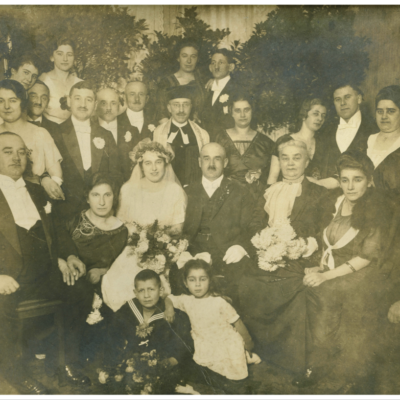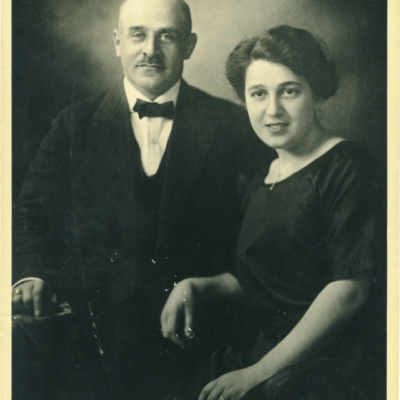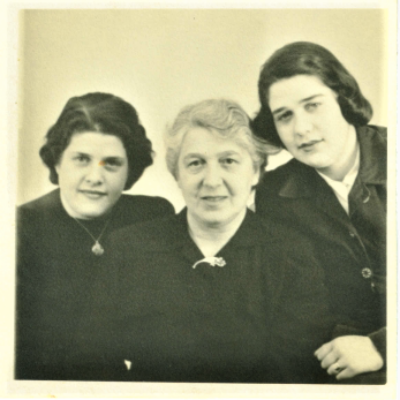Thea Bendix Nathan
Biography
One of five children, Thea (whose legal German name was Thekla) was born in Burgsteinfurt, Germany. She married Georg Nathan of Emmerich, Germany in 1920, and the couple made their home in Emmerich. Georg was a prosperous cattle trader and owned considerable land; the family was quite well off, and their life was very good. Thea was a housewife and kept an immaculate German home. The family had “a laundry lady” who came in to do the family wash, also cooking, baking, and even keeping the books for Georg’s business.
But life changed dramatically for the Nathan family on Kristallnacht when their home was ransacked and Georg was jailed briefly. Thea’s daughters could no longer go to local schools; they had to complete their educations in other cities. They returned home when the notice of deportation arrived, as the family had made the decision to stay together.
On December 10, 1941, the Nathan family boarded trains, ending up in the Jewish ghetto in Riga, Latvia. Life in the ghetto was very hard for Thea and her family: it was bitter cold; living conditions were miserable; and there was never enough to eat. While Sophie and Emmi went out every day to work, Thea remained inside to help in the ghetto.
Georg died in the ghetto in May, 1942. Thea and her children, like others, worked to stay alive and to have food to eat. Occasionally they traded things for food, a very dangerous undertaking as prisoners could be shot for bringing food into the ghetto. After the ghetto was emptied of prisoners, the three Nathan women were sent to another camp only to be returned. In Armee Bekleidungs Amt (the army clothing office), Thea separated the dirty clothes that came in from the war front. She cut the elastic off the glasses soldiers had worn, and her daughters took the elastic into town to swap for other things. Meanwhile, all around the three of them, men, women, and children were being taken off and killed.
Thea’s life was spared on three different occasions. Once, she was in the hospital for exhaustion when the SS were sorting out the sick and older people, who were then being picked to be sent out. The soldier had chosen Thea; one of the soldiers, however, spoke up that Thea worked for him, and that she had two daughters who also worked hard for the SS. Thea’s life was spared.
She was spared again, rushing to a bunker in December of 1922 during a bombing at Liba. Because she had such a nasty cut on her leg, the people sitting at the front of the bunker offered her a place, but Thea wanted to go to the back so that the she, Sophie, and Emmi could stay together. The bomb fell, hit the entrance, and several people were killed.
On liberation day, May 2, 1945, Thea was so ill that she almost had to be carried out to freedom. Thea, Sophie, and Emmi traveled to Denmark and then on to Sweden where Thea recovered.
In April 1946, Thea, Sophie, and Emmi arrived in New York. Thea went to live with a cousin in New York. She alternated her time between her daughters, living part time in Anniston with Sophie and part time in Philadelphia with Emmi. She died in Philadelphia and is buried there.
Photos & Documents
More Information
Oldest to Youngest:
Moritz Bendix
Louis Bendix
Paula Bendix Katzmann (Hermann)
*Thea Bendix
Georg Nathan
(1880 Emmerich, Germany – 1942 Riga Ghetto)
Married October 20, 1920 in Burgsteinfurt, Germany
Emmi Nathan (Hans Loewenstern)
(1925 Emmerich – 2018 Philadelphia, PA)
Sophie Nathan (Heinz “Henry” Nathan)
(1921 Emmerich – 2002 Anniston, AL)
Riga, Latvia
(1941-1943)
ABA (Armee Bekleidungs Amt.) in Riga
(1943-1944_
Liepaja (Libau), Latvia
(1944-1945)
Kaiserwald, Latvia
(1943)
Fuhlsbuettel Prison in Hamburg (subcamp of Neuengamme)
(1945)
Kiel, Germany
(1945)
Fuhlsbuettel (Hamburg, Germany) to Kiel, Germany: April 12-15, 1945
Kiel, Germany (Arbeitserziehungslager Nordmark)
Malmo, Sweden 1945
Holsbybrunn, Sweden 1945-46
Resources
-
History & Related Resources
Survivor Stories, Thea Bendix Nathan
Temple Beth-El / Anniston
Written by Sherry Blanton, 2010








